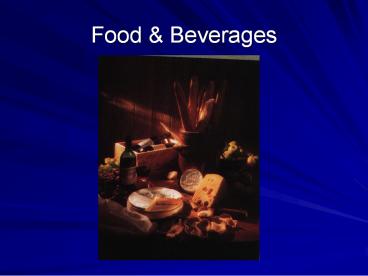Food - PowerPoint PPT Presentation
1 / 17
Title: Food
1
Food Beverages
2
- I. All foods have Microorganisms on their
surface. - II. Microorganisms take food for metabolism and
turns it into acids, alcohols, gas. - III. Sometimes desirable pleasant tastes
textures. - IV. foods altered by the careful
controlled growth of microorganisms - A. sour cream blue cheese.
- B. Spoilage, sour milk, molded bread does
not change the quality of food but may lead to
illness
3
- V. Factors Influencing the growth of organisms on
foods - A. (aW)
- 1. Bacteria - .9 or higher for growth
- 2. Fungi lower aW
- B.
- Most are inhibited by acidic conditions.
- C.
- Low temperatures slow down enzymatic
activities. - D.
- 1. Nutrients
- 2. Coverings
- 3. Antimicrobials
4
- VI. Production of foods beverages
- A. BC Sumerians Babylonians
- B. BC Egyptians bread beer
- C. Milk
- 1. from cow but leads to contamination.
- 2. Lactic Acid
- 3. Yogurts
- a to eliminate undesirable spoilage.
- b. Inoculated with Streptococcus thermophiles
or Lactobacillus bulgaricus. - c. Incubated at 40C.
- d. Produces lactic acid, pH drops causing
of milk protein which changes texture. - e. Conditions are controlled so only certain
bacteria can grow. - f. ½ million pounds of yogurt is sold in US,
yearly
5
- 4. Cheese
- a. yrs ago Asia
- b. Steps
- 1. Milk inoculated with starter culture
(Lactic Acid bacteria). - 2. Incubated until fermentation of milk
sugars - 3. (enzyme) is added to milk proteins
(CURD). - 4. (CURD) is separated from liquid
(WHEY). - 5. cottage cheese, - Cheese
6
- c. Types of cheeses
- 1. White fungus, Pencillium caseisolon
- 2. Bacteria, Brevibacterium linen
- 3. Bacteria, Propionibacterium sp.
- a. Produces propionic acid CO2.
- 4. Cheeses content
- a. very hard, semi, soft
7
- D. Pickled Vegetables Olives
- 1. Made with bacteria
- E. Sauerkraut
- 1. Cabbage is shredded layered with .
- 2. Salt out cabbage to prevent bacteria
growth. - 3. Permits bacterial growth (Lactobacillus
plantarian) in 2- 4 weeks. - 4. pH levels results in tangy taste
8
- F. Soy Sauce
- 1. soy bean Aspergillus oryzae.
- 2. Mix salt, soy bean, wheat
- 3. Let sit for 3 days
- 4. Carbohydrates are broken down to produce
fermentable sugars. - 5. Mixed with 18 bacterium
(Pediococcous soyae saccharomyces rouxi) for
8 12 months. - 6. Liquid is drained for soy sauce
9
- G. Breads Bakers Yeast
- 1. Leavened Bread.
- 2. Mixture of flour, sugar, milk, water,
yeasts (Saccharomyces cerevisiae), butter or
oil. - 3. ferments carbohydrates from sugar to
. - 4. Produces ethanol gas which is in baking.
- 5. CO2 causes bread to .
10
- H. Alcohols
- 1. From fruits.
- 2. 10 million yeast cells on grapes.
- 3. Fruit sits for days at room temperature and
begins to bubble as juices ferment. - 4. Weeks mixture alcohol
11
- 5. Wine
- a. Crush selected grapes solids juices
. - b. Red wine
- 1. Red grapes
- 2. Entire grape
- c. Only juice from red grapes
- d. red for a day then only juices
ferments. - e. S. cerevisicae for growth.
- f. , controlled temperature for days to
weeks. - g. Sugar
- Ethyl alcohol CO2.
- Less than 14 alcohol
12
- 6. Beer
- a. Fermentation of sugars from grain by
Saccharamyces. - b. starch to sugars
- 1. (germinating grain) is soaked in water
to yield an extracting enzyme (wort) sugars
nutrients for yeast growth. - c. is boiled to destroy enzyme most
microorganisms. - d. are added for flavor inhibited unwanted
bacterial growth. - e. Brewers Yeast alcohol.
- f. Sits in vats to settle out solids including
yeast microorganims flavoring. - g. S carlsbergensis 6 12 C 8-14 days
(American beer). - h. S cereviside 14-23 C 5 7 days,
carried to top by CO2. Stouts.
13
- 7. Distilled Spirits
- a. Similar to beer except boiled.
- b. continues during fermentation.
- c. Alcohol is separated by .
- d. sugar cane or molasses.
- e. barley aged in oak or cherry barrels.
- 8. Vinegar
- a. Product of oxidation of ethyl alcohol by
acetic acid bacteria. - b. 4 acetic acid.
14
- VI. Food Spoilage
- A. Growth of on or in food that produces an
undesirable change. - B. of food determines the type of
microorganism . - C. Bacteria commonly involved in food spoilage
- 1. Gram Negative
- a. . Wide range of food temp.
- b. . Degrade fruits vegetables.
- c. . ethyl alcohol to acetic acid
- d. . degrade cottage cheese
15
- 2. Gram positive
- a. Streptococcus, Leuconstoc Lactobacillus
- b. Bacillus Clostridium .
- c. B. coagulans Strearothermophils sour
spoilage of some . - D. Fungus
- 1. Rhizopus sp.
- 2. Aspergillus
16
- VII. Food Borne illness
- A.
- 1. Hours
- 2. Consumption of a toxin produced by a
microorganism growing on a food product. - ex. Staphylococcus aureus ham, pasteries,
salads - nausea vomiting.
- B.
- 1. Neurotoxin by Clostidium botulinea (Gram
positive) - 2. Errors in canning with endospore
contamination. - ex canned food bulging
- C. - Salmonella E. Coli
- 1. Infection after ingestion in the small
intestines by a living organisms. - 2. Up to 24 hrs to feel effects resulting in
diherrhea - 3. Prevention
- a. Thoroughly cook food.
- b. Wash cutting board to prevent cross
contamination.
17
- IX. Food Preservation
- A. Drying
- B. High Temperatures
- C. Low Temperatures
- D. Irradaition
- E. Sugar
- F. Smoked
- G. Pasteurization
- 1. High temp
- 2. Low temp
- 3. Ultra high































